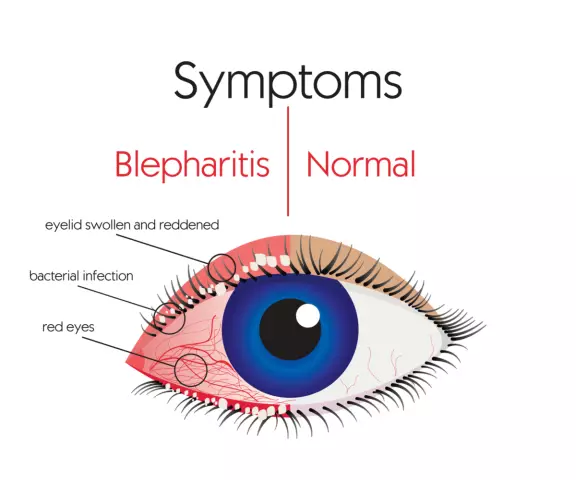- Author Rachel Wainwright [email protected].
- Public 2023-12-15 07:39.
- Last modified 2025-11-02 20:14.
Blepharitis

Blepharitis is an inflammation of the edge of the eyelid. This common disease, prone to chronic course, occurs in people of any age, for example, blepharitis in children is the most common eye disease.
With blepharitis, the eye as a whole may remain unchanged, which often leads to the misconception that the disease is minor and does not require treatment. In fact, this is not the case, and with a prolonged course of blepharitis, the eyes are exposed to constant infectious effects, which can cause significant problems, including visual impairment.
The reasons for the development of blepharitis
Usually the disease is caused by an infectious (bacteria, fungi, mites) or allergic agent. Blepharitis can be caused by various reasons, but whatever the immediate cause of the inflammation of the eyelid, in the development of blepharitis, reduced immunity is of paramount importance, as a result of recent or existing common diseases. Blepharitis often develops in people suffering from diabetes, helminthiases (helminthic infestations), tuberculosis, cancer, etc. Often, blepharitis is accompanied by uncorrected hyperopia. In the last decade, one of the common causes of blepharitis has become dry eye syndrome, when, due to rare blinking, the cornea is not sufficiently lubricated with tear fluid. This condition is typical of people who spend a lot of time in front of a computer monitor. In children, blepharitis is often caused by poor hygiene (infection with dirty hands).
Types of blepharitis
By location, blepharitis happens:
- Anterior marginal. In this type of blepharitis, only the anterior, ciliary edge of the eyelid is affected.
- Rear edge. The posterior edge of the eyelid, containing the meibomian glands, is affected.
- Angular, or angular. Inflammation is concentrated in the corners of the eyes.
Depending on the causing cause, they are distinguished:
- Seborrheic (scaly) blepharitis. Often combined with manifestations of seborrhea on the eyebrows, scalp.
- Ulcerative blepharitis is caused by a staphylococcal infection in the hair follicles of the eyelashes, resulting in their purulent inflammation, then turning into ulceration.
- Demodectic blepharitis. It is caused by the Demodex folliculorum or Demodex brevis mite, which enters the ciliary follicles and meibomian glands.
- Allergic blepharitis. It usually manifests itself in combination with allergic lesions of the mucous membrane of other parts of the body. Microparticles of the skin of pets, pollen of flowering plants, medicines, dust, household chemicals, etc. can act as an allergen.
- Rosacea, or acne blepharitis. Usually accompanies rosacea.
Blepharitis symptoms

Common symptoms of blepharitis include redness and swelling of the eyelid margin, itching or unpleasant burning sensation in the affected area, as well as the appearance of various inflammatory formations. Ulcerative blepharitis is characterized by the formation of ulcers along the edges of the eyelids, for seborrheic blepharitis - gray sebaceous scales, for demodectic blepharitis - the appearance of sticky discharge from the follicles of the eyelashes, with allergic blepharitis, abundant mucous discharge appears, for blepharitis rosacea, the appearance of small grayish-red nodules is characteristic, subsequently passing … With blepharitis, the eyes quickly get tired, increased sensitivity to light appears, sometimes turning into photophobia. Since the manifestations of the disease are often associated with ciliary follicles, one of the characteristic symptoms of blepharitis is changes in the eyelashes, which can discolor, fall out,take the wrong direction of the rasta.
Blepharitis in children is characterized by the fact that the child constantly rubs his eyes, shows an increased reaction to light, in the morning the eyes stick together from dried secretions. Most often, blepharitis in children is in ulcerative and allergic form.
Diagnosis of blepharitis
Diagnosis is usually straightforward due to the characteristic symptoms of blepharitis. Diagnosis is by slit-lamp examination of the eyelid. Clarification is necessary to determine the infectious agent, for which scraping is carried out from the conjunctiva and roots of the eyelashes, followed by laboratory examination of the material obtained. If the allergic nature of blepharitis is established, allergy tests are performed to identify the allergen.
Blepharitis treatment
Blepharitis refers to diseases that are difficult to treat, and is prone to chronic recurrent course. Therefore, the treatment of blepharitis must be persistent and consistent, and also include, in addition to local procedures, fortifying methods aimed at strengthening the immune system. For this, vitamin therapy and the use of immunostimulating drugs of mild action are used from medications, for example, "Immunal", a herbal preparation, which contains Echinacea purpurea juice.
If hyperopia is found, it is imperative to take measures to eliminate it with corrective lenses or glasses. Dry eye syndrome also needs to be eliminated, for which you need to take breaks from computer classes every half hour, maximum an hour. In case of already developed dry eye syndrome, instillation of adrenaline-containing drops, for example, "Vizina", is used.
Topically, for the treatment of blepharitis, anti-inflammatory drugs are used in the form of lotions, ointments and drops. If a specific infectious agent is identified in the form of staphylococcus or demodex, antibiotics or anti-mite agents are used. Careful observance of eye hygiene and refusal to use cosmetics for the entire duration of blepharitis treatment is necessary.
Treatment of blepharitis with folk remedies
Since the treatment of blepharitis can sometimes last for many months, taking medications for such a long time may be undesirable, or they may need to be changed periodically to prevent allergic reactions. In this case, a good alternative is to use folk remedies for the treatment of blepharitis.

Most often of the folk remedies for blepharitis, eye washing and lotions are used with the help of decoctions and infusions of medicinal herbs. For this purpose, flowers of chamomile, calendula, cornflower, sage leaves, eucalyptus are used. One of the most commonly used folk remedies for blepharitis is a decoction of onions with the addition of a small amount of boric acid, which is used to wash the eyes several times a day. Also, washing the eye with an infusion of black and green tea taken in equal proportions has a good effect.
When treating blepharitis with folk remedies, two points must be considered. The first is that herbal preparations, as well as medications, can cause an undesirable reaction (for example, allergies or irritation), and it is advisable to consult an ophthalmologist before using them. And second, the use of folk remedies for blepharitis to achieve a therapeutic effect should be frequent (several times a day) and long-term.
YouTube video related to the article:
The information is generalized and provided for informational purposes only. At the first sign of illness, see your doctor. Self-medication is hazardous to health!






